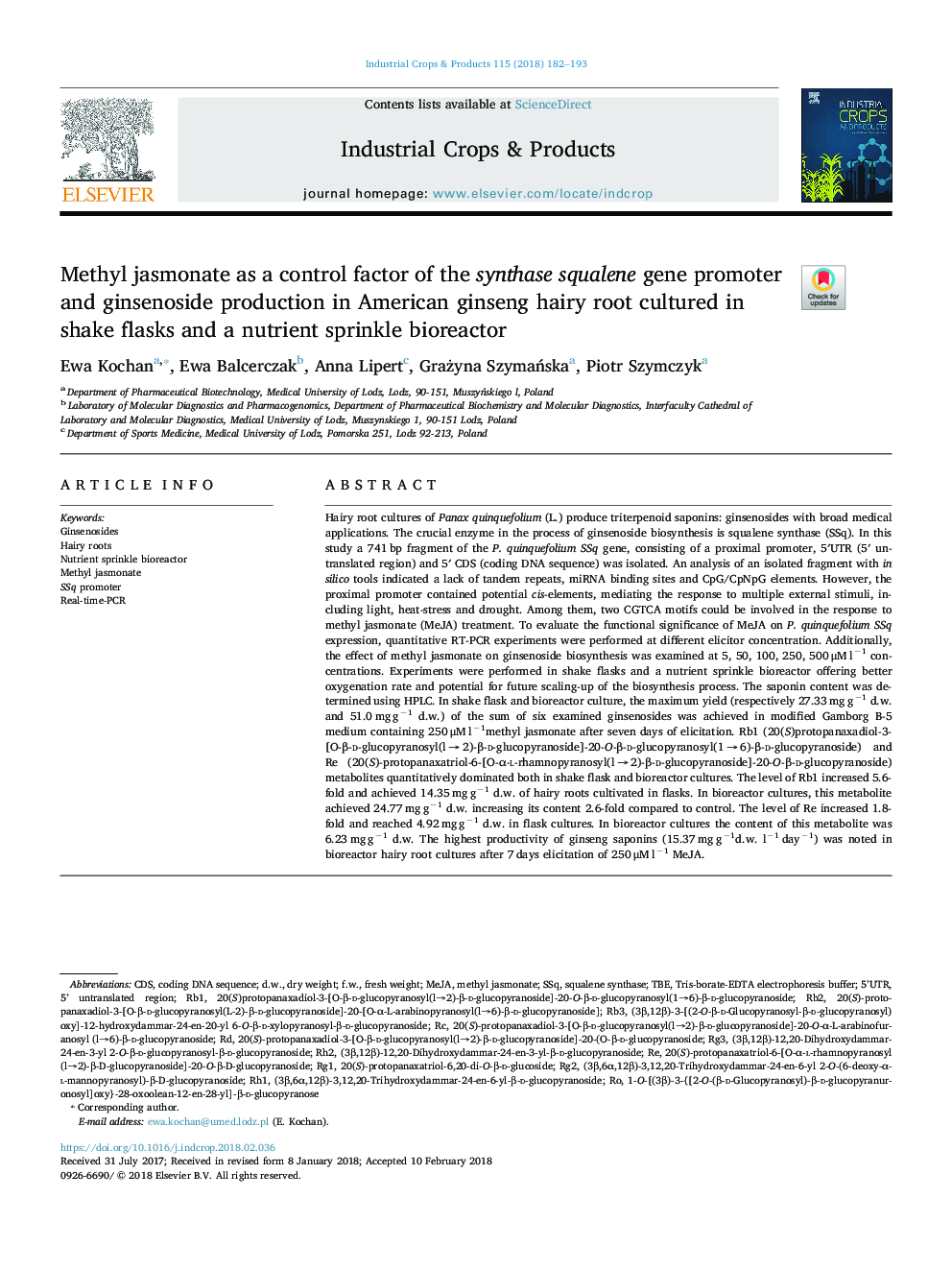| کد مقاله | کد نشریه | سال انتشار | مقاله انگلیسی | نسخه تمام متن |
|---|---|---|---|---|
| 8880320 | 1624795 | 2018 | 12 صفحه PDF | دانلود رایگان |
عنوان انگلیسی مقاله ISI
Methyl jasmonate as a control factor of the synthase squalene gene promoter and ginsenoside production in American ginseng hairy root cultured in shake flasks and a nutrient sprinkle bioreactor
ترجمه فارسی عنوان
متیل جاسمونیت به عنوان عامل کنترل پروموتور ژن سکتانت اسکالن و تولید ژینزوزید در ریشه مو جینسنگ آمریکایی کشت شده در فلاسک های لرزش و یک ماده مغذی بکار
دانلود مقاله + سفارش ترجمه
دانلود مقاله ISI انگلیسی
رایگان برای ایرانیان
کلمات کلیدی
RB1RB2Rg3RH1RH2Rg1SSQTBEF.W.D.W.squalene synthase - اسکالن سنتازHairy roots - ریشه های مودارReal-time-PCR - زمان واقعی PCRMethyl jasmonate - متیل جاسموناتMeJA - میاfresh weight - وزن ترdry weight - وزن خشکCdS - کادمیم سولفید، سولفید کادمیمCoding DNA Sequence - کدگذاری دنباله DNAGinsenosides - گینسنوزیدس
موضوعات مرتبط
علوم زیستی و بیوفناوری
علوم کشاورزی و بیولوژیک
علوم زراعت و اصلاح نباتات
چکیده انگلیسی
Hairy root cultures of Panax quinquefolium (L.) produce triterpenoid saponins: ginsenosides with broad medical applications. The crucial enzyme in the process of ginsenoside biosynthesis is squalene synthase (SSq). In this study a 741â¯bp fragment of the P. quinquefolium SSq gene, consisting of a proximal promoter, 5â²UTR (5â² untranslated region) and 5â² CDS (coding DNA sequence) was isolated. An analysis of an isolated fragment with in silico tools indicated a lack of tandem repeats, miRNA binding sites and CpG/CpNpG elements. However, the proximal promoter contained potential cis-elements, mediating the response to multiple external stimuli, including light, heat-stress and drought. Among them, two CGTCA motifs could be involved in the response to methyl jasmonate (MeJA) treatment. To evaluate the functional significance of MeJA on P. quinquefolium SSq expression, quantitative RT-PCR experiments were performed at different elicitor concentration. Additionally, the effect of methyl jasmonate on ginsenoside biosynthesis was examined at 5, 50, 100, 250, 500â¯Î¼Mâ¯lâ1 concentrations. Experiments were performed in shake flasks and a nutrient sprinkle bioreactor offering better oxygenation rate and potential for future scaling-up of the biosynthesis process. The saponin content was determined using HPLC. In shake flask and bioreactor culture, the maximum yield (respectively 27.33â¯mgâ¯gâ1 d.w. and 51.0â¯mgâ¯gâ1 d.w.) of the sum of six examined ginsenosides was achieved in modified Gamborg B-5 medium containing 250â¯Î¼Mâ¯lâ1methyl jasmonate after seven days of elicitation. Rb1 (20(S)protopanaxadiol-3-[O-β-d-glucopyranosyl(lâ¯ââ¯2)-β-d-glucopyranoside]-20-O-β-d-glucopyranosyl(1â¯ââ¯6)-β-d-glucopyranoside) and Re (20(S)-protopanaxatriol-6-[O-α-l-rhamnopyranosyl(lâ¯ââ¯2)-β-d-glucopyranoside]-20-O-β-d-glucopyranoside) metabolites quantitatively dominated both in shake flask and bioreactor cultures. The level of Rb1 increased 5.6-fold and achieved 14.35â¯mgâ¯gâ1 d.w. of hairy roots cultivated in flasks. In bioreactor cultures, this metabolite achieved 24.77â¯mgâ¯gâ1 d.w. increasing its content 2.6-fold compared to control. The level of Re increased 1.8-fold and reached 4.92â¯mgâ¯gâ1 d.w. in flask cultures. In bioreactor cultures the content of this metabolite was 6.23â¯mgâ¯gâ1 d.w. The highest productivity of ginseng saponins (15.37â¯mgâ¯gâ1d.w. lâ1â¯dayâ1) was noted in bioreactor hairy root cultures after 7â¯days elicitation of 250â¯Î¼Mâ¯lâ1 MeJA.
ناشر
Database: Elsevier - ScienceDirect (ساینس دایرکت)
Journal: Industrial Crops and Products - Volume 115, May 2018, Pages 182-193
Journal: Industrial Crops and Products - Volume 115, May 2018, Pages 182-193
نویسندگان
Ewa Kochan, Ewa Balcerczak, Anna Lipert, Grażyna SzymaÅska, Piotr Szymczyk,
